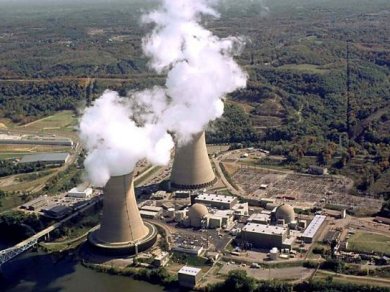In a nuclear station, electricity is generated through heat which turns water into steam in steam generators. The steam is then used to drive turbine generators. This is similar to the process of generating electricity in a coal-fired steam station. The main difference is the source of heat.
In nuclear power stations, uranium atoms undergo fissioning or splitting. The chain reaction produces heat which is transferred to water. In coal-fired steam stations burning of coal is the source of heat.
There are two types of nuclear reactors in common usage today—the boiling-water reactor (BWR) and the pressurized water reactor (PWR). In BWRs, such as the ones at Fukushima Daiichi, Japan, the heated water is allowed to boil and turn into steam to turn the generator. In PWRs, which constitute many of the western nuclear power plants, the heated water is kept under pressure so that it heats but does not boil (see picture below). Water from the reactor and the water that is turned into steam are in separate pipes and never mix.
In both types, electrical pumps keep the water running, and an additional water system (connected to a cooling tower or, e.g., a lake) cools the steam.
.gif)
References
- US Nuclear Regulatory Commission (accessed March 14, 2011)
- Richard Black, Uncertainty surrounds Japan’s nuclear picture, BBC 12 March 2011. (accessed March 14, 2011)
- Generating Electricity with Nuclear Power Duke Energy, Charlotte, NC, USA. (accesed March 14, 2011)
- How Nuclear Power Stations Work, Department of Atomic Energy, India. (accessed March 14, 2011)
- US Department of Energy (Resources for students) (accessed March 14, 2011)
- US Department of Energy (Resources for teachers) (accessed March 14, 2011)
Also of Interest
- Nuclear Meltdown
General facts on a nuclear meltdown - General Facts on Radioactivity
General facts on radiation, inhalation, and radioactive isotopes




